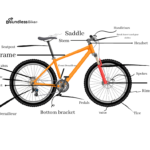The best way to ensure you get the right bike size is to use bike size charts. Many bike manufacturers provide comprehensive size charts to make it easier for you to find the right size bike for your height, weight, and other measurements. These charts are quite handy, as they provide a comprehensive breakdown of the sizes, measurements and other details you need to consider before you make a purchase. This will bike size chart guide will help you to get the right size bike for your body and riding style. Let’s begin.
Bike Size Chart by Height
When choosing a bike, the ideal way to determine the perfect size is to take a test ride. Even if the frame size looks right on paper, you won’t be sure until you’ve taken it for a spin. However, it’s difficult to take a test ride if your buying a bike online. If you’re considering a purchase from an online store, make sure that they have a generous return policy. If you’re looking to purchase a new bike, it’s important to consider what size will work best for you. While you can use our bike size chart as a general guide.
Road Bike Size Chart
| Biker Height | Inseam | Bike Frame Size | Marker |
|---|---|---|---|
| 4’10” – 5’1″ | 25″ – 28″ | 47 – 50 cm | XS |
| 5’1″ – 5’5″ | 28″ – 31″ | 50 – 53 cm | S |
| 5’5″ – 5’9″ | 31″ – 34″ | 53 – 56 cm | M |
| 5’9″ – 6’0″ | 34″ – 37″ | 56 – 58 cm | L |
| 6’0″ – 6’3″ | 37″ – 40″ | 58 – 61 cm | XL |
| 6’3″ – 6’6″ | 40″ – 43″ | 61 – 64 cm | XXL |
When it comes to purchasing a road bike, finding the right size is essential for both performance and comfort. The traditional method for determining road bike size is by measuring the saddle tube length, which is the distance between the bottom bracket cup’s center and the seat tube’s top. However, other dimensions such as top frame length, shoot length, and handle reach also play a role in determining the rider’s spinal tilt while riding. To help you find the right size road bike, many manufacturers provide a size chart that corresponds to your height and inseam measurements. These charts provide a general guide to the appropriate frame size, but it is always recommended to test ride a bike before making a purchase to ensure the best fit and comfort.
Mountain Bike Size Chart
| Biker Height | Inseam | Bike Frame Size | Marker |
|---|---|---|---|
| 4’10” – 5’1″ | 25″ – 28″ | 13″ – 14″ | S |
| 5’1″ – 5’5″ | 28″ – 31″ | 15″ – 16″ | S/M |
| 5’5″ – 5’9″ | 31″ – 34″ | 17″ – 18″ | M |
| 5’9″ – 6’0″ | 34″ – 37″ | 19″ – 20″ | L |
| 6’0″ – 6’3″ | 37″ – 40″ | 21″ – 22″ | L/XL |
| 6’3″ – 6’6″ | 40″ – 43″ | 23″ – 24″ | XL |
Mountain bike sizing conventions have changed over time. Before 2000, mountain bikes used A-frame geometry similar to road bikes but with smaller wheels and higher bottom brackets. They also featured flat handlebars for better control and longer cranks for climbing. Sizes like 16.5 inches, 17.5 inches, 19 inches, and 21 inches were standard. In the 2000s, manufacturers switched to a small, medium, and large convention, with extra small and extra large sizes available. A general rule of thumb is that small sizes are for people 4’11” to 5’4″, mediums are for 5’5″ to 5’9″, and larger sizes are for 5’10” to 6’3″. Keep in mind that tire size may need to be compromised for maximum comfort, and always test ride the bike before purchasing to ensure satisfaction.
How to calculate Bike size? step by step process.
The process of calculating bike size typically involves measuring the rider’s body and comparing those measurements to a size chart provided by the bike manufacturer. Here is a general overview of the process:
- Measure your height: Stand against a wall with your shoes off and have a friend or family member measure the distance from the floor to the top of your head. This will give you your overall height in inches or centimeters.
- Measure your inseam:

Inseam is a measure of the distance from the floor to the crotch of a person. It is used to determine the appropriate size of a bike frame for a person. To calculate inseam, you will need the following items:
- A hardcover book
- A tape measure
- A pair of shoes that you will wear when cycling
To measure your inseam:
- Stand up straight with your shoes on and your feet shoulder-width apart.
- Place the hardcover book between your legs, making sure that it is pressed up against your crotch.
- Using the tape measure, measure the distance from the top of the book to the floor.
- Record this measurement as your inseam.
- City bike – Leg inseam (cm) x 0,685 = Your frame size
- Mountain bike – Leg inseam (cm) x 0,66 = Your frame size
- Road bike – Leg inseam (cm) x 0,70 = Your frame size
It’s important to note that the inseam measurement is taken while standing with your back against a wall, this will make the measurement more accurate.
- Compare your measurements to a size chart: Bike manufacturers provide size charts that correspond to the rider’s height and inseam measurements. These charts will provide a general guide to the appropriate frame size for your body.
- Test ride the bike: Even if your measurements match a specific size on the size chart, it’s always best to test ride the bike before making a purchase to ensure the best fit and comfort.
- Take into account the riding style and preference, a more aggressive rider may prefer a smaller bike, while a recreational rider may prefer a larger bike.
Bike Size Chart for Hybrids
Sizing a hybrid bike is important for both comfort and performance. It is typically measured by the frame size, which is measured in inches from the center of the crank to the top of the seat tube. Hybrid bikes are similar in size to mountain bikes and are often smaller than road bikes. The best way to determine the correct size is to use your height and inseam measurements, with inseam being the more critical number. It is recommended to take a test ride to ensure proper fit and many bike shops offer loaner bikes for test rides. When purchasing a used bike, it is helpful to have a professional fitting or to use the above measurements as a starting point.
| Height | Bike Size (numeric) | Marker (Inch) |
| 4’10”-5’2” | 13”-14” | X-Small |
| 5’2”-5’6” | 15”-16” | Small |
| 5’6”-5’10” | 17”-18” | Medium |
| 5’10”-6’1” | 19”-20” | Large |
| 6’1”-6’4” | 21”-22” | X-Large |
| 6’4”-6’6” | 22”-24” | XX-Large |
Bike Size Chart for Women
When choosing the right bike size for a woman, there are several key points to consider:
- Frame size: The frame size is the most important factor in determining if a bike will fit properly. A size chart can be used as a reference, but it’s best to visit a bike shop for a proper fitting.
- Standover height: This is the distance between the ground and the top tube of the bike when the bike is standing upright. It’s important to have enough clearance between the rider’s body and the top tube to ensure safety and comfort while riding.
- Top tube length: This measurement is the distance between the seat and the handlebars. A proper top tube length will ensure a comfortable riding position.
- Seat tube length: This measurement indicates the size of the bike frame and is usually given in millimeters.
- Inseam: A rider’s inseam measurement can be used in conjunction with a size chart to determine the appropriate bike size.
- Personal preference: It’s important to consider personal preferences and riding style, such as the type of terrain you’ll be riding on and the distance you’ll be riding.
- Brand and Models: Different bike brands and models have their own sizing standards, so it’s recommended to consult the specific brand’s size chart or visit a bike shop for assistance.
- Test ride: It’s always best to test ride a bike before buying it to ensure it feels comfortable and fits properly.
| Height | Bike Size (numeric) | Marker (Inch) |
| 4’10”-5’2” | 13”-14” | X-Small |
| 5’2”-5’6” | 15”-16” | Small |
| 5’6”-5’10” | 17”-18” | Medium |
| 5’10”-6’1” | 19”-20” | Large |
Kids’ Bike Size Chart
Sizing a kids’ bike can be challenging, but it is important for proper balance and performance. Wheel size is commonly used to measure children’s bikes, with options ranging from 12” to 24”. A child’s height and inseam are also important considerations, but it is also important to consider factors such as weight, geometry, brakes, tires, and whether or not to use training wheels.
A basic bike size chart for children is provided, but it’s important to keep in mind that children can quickly outgrow a bike and that it is not necessary to spend a fortune on upgrading bikes every year. Parents should consider their child’s riding ability and confidence when deciding on the size of the bike, and should seek a used bike or borrow a bike from a friend if their child is at the higher end of the ideal height/inseam for a bike.
Here’s the same chart as above, but using height in feet:
| Height (feet) | Age | Bike Size (inches) |
|---|---|---|
| 3’1″ – 3’7″ | 2-4 | 12-14 |
| 3’7″ – 4’0″ | 4-5 | 14-16 |
| 4’0″ – 4’4″ | 5-6 | 16-20 |
| 4’4″ – 4’8″ | 6-8 | 20-24 |
| 4’8″ – 5’4″ | 8-9 | 24-26 |
| 5’4″ – 5’6″ | 9-11 | 26-28 |
Things to consider choosing your next bike
- Height and Inseam
When selecting a bicycle, one’s physical height and inseam length are key considerations. Every person has a unique body type and build, which affects the inseam length they require. For instance, a 6’2″ man may have a broad chest and a relatively short inseam of 32″, while another man of the same height may have a slim frame and longer legs, resulting in an inseam of 36″. This concept is also applicable to female riders and children.
- Frame Importance
Choosing the right bike frame size is crucial for a comfortable and efficient ride. A frame that is too small can cause discomfort and restrict your movement, while a frame that is too large can make it difficult to achieve optimal power and speed. One way to determine the appropriate frame size is by standing over the frame with both feet firmly planted on the ground. For mixed, sprinting, or touring bikes, it is ideal to have about an inch of space between your crotch and the top tube of the frame.
- Mountain Bike Frame
When choosing a mountain bike, it is important to ensure that the frame size is appropriate for the rider’s body. The distance between the rider’s pelvis and the top tube of the frame should be around 2 inches. This can be determined by having the rider sit on the seat of the bike with their feet on the ground and comfortably reaching the handlebars. For children, the distance between their crotch and the top tube of the frame should be around 25 to 50mm when they are in the same seated position.
- Position of the Seat
When evaluating the fit of a bike, it is important to consider the rider’s individual preferences and comfort level. Some riders prefer a slight forward inclination of the seat while others prefer a slight backward inclination. The key is to find the posture that allows the rider’s legs to comfortably rest on the pedals, and allows for the rider to nearly reach the ground when stretching their legs. It is also important that the rider doesn’t have to excessively move their hips from side to side to reach the pedals or the ground.
- Handlebars and Their Position
Proper positioning of the handlebars is crucial for a comfortable and efficient ride. Incorrect positioning can lead to back pain, stiff wrists, and sore shoulders. Handlebar positioning varies depending on the type of bike. For racers or touring bikes, the handlebars are often the same width as the rider’s shoulders. On road bikes, the handlebars are typically placed about an inch below the top of the saddle.
For mountain bikes, the handlebars are lower to create a higher center of gravity. On hybrid bikes, the handlebars are positioned for a relatively upright torso due to the high seat. It is important to note that these positions are not fixed and can be adjusted to fit the rider’s body type and riding style. The handlebar grips can also be altered to fit the rider’s preference. When choosing a bike, it is important to consider the handlebar position and make necessary adjustments for a comfortable and efficient ride.
- Wheel Size Measurements
The size of the wheel on a bike is determined by measuring the diameter of the wheel after the tire is mounted. In most cases, the size is printed on the sidewall of the tire. The intended use of the bike plays a significant role in determining the appropriate wheel size. For example, most mountain bikes come with either a 26″ or 29″ tire, with larger mountain bike enthusiasts often opting for the 29″ wheel. Trail bike tires are also typically larger.
On the other hand, mixed, racing and touring bikes typically have a narrower 29″ wheel (usually 18-25mm), which allows for easy movement across the ground. Historically, road bikes had 27″ wheels. BMX bikes usually have wheel diameters ranging from 20″ to 24″. The size of the wheel has a significant impact on the overall dimensions of the bike. For children, the size of the wheel can vary, but they typically range from 12″ for ages 3-5, 16″ for ages 5-7, 20″ for ages 7-10 and 24″ or 26″ for ages 10 and up.
FAQ
Figure out what type of bike you will be using and then consult a bike size chart. Mountain, road and hybrid bikes all use different size systems, so it’s important to look at the right chart for the right type of bike.
Bike sizes are generally based on frame height and length. Your frame should fit your body size so that you can comfortably reach the handlebars and pedals and also helps ensure proper posture for maximum power output when cycling.
If you find yourself between sizes on a bike size chart due to having either long or short legs for your given height, always go on the side of choosing the larger frame option as this will provide more room for adjusting components such as saddle height or stem length down the line if needed.
Saddle height, Crank Length, Handlebar Height & Reach.
Conclusion
Sizing a bike can be complicated and can vary depending on the type of bike, brand, and rider. It’s important to take your time, consider different options, and get multiple opinions before making a decision. A well-fitted bike is essential for comfort, performance, and injury prevention. Factors to consider include the size of the bike and its geometry. Additionally, it’s important to keep in mind that different types of bikes may have different size measurements, and it’s important to use the bike for its intended purpose after proper training.
Also check Bicycle parts names- A to Z Beginner’s Guide






